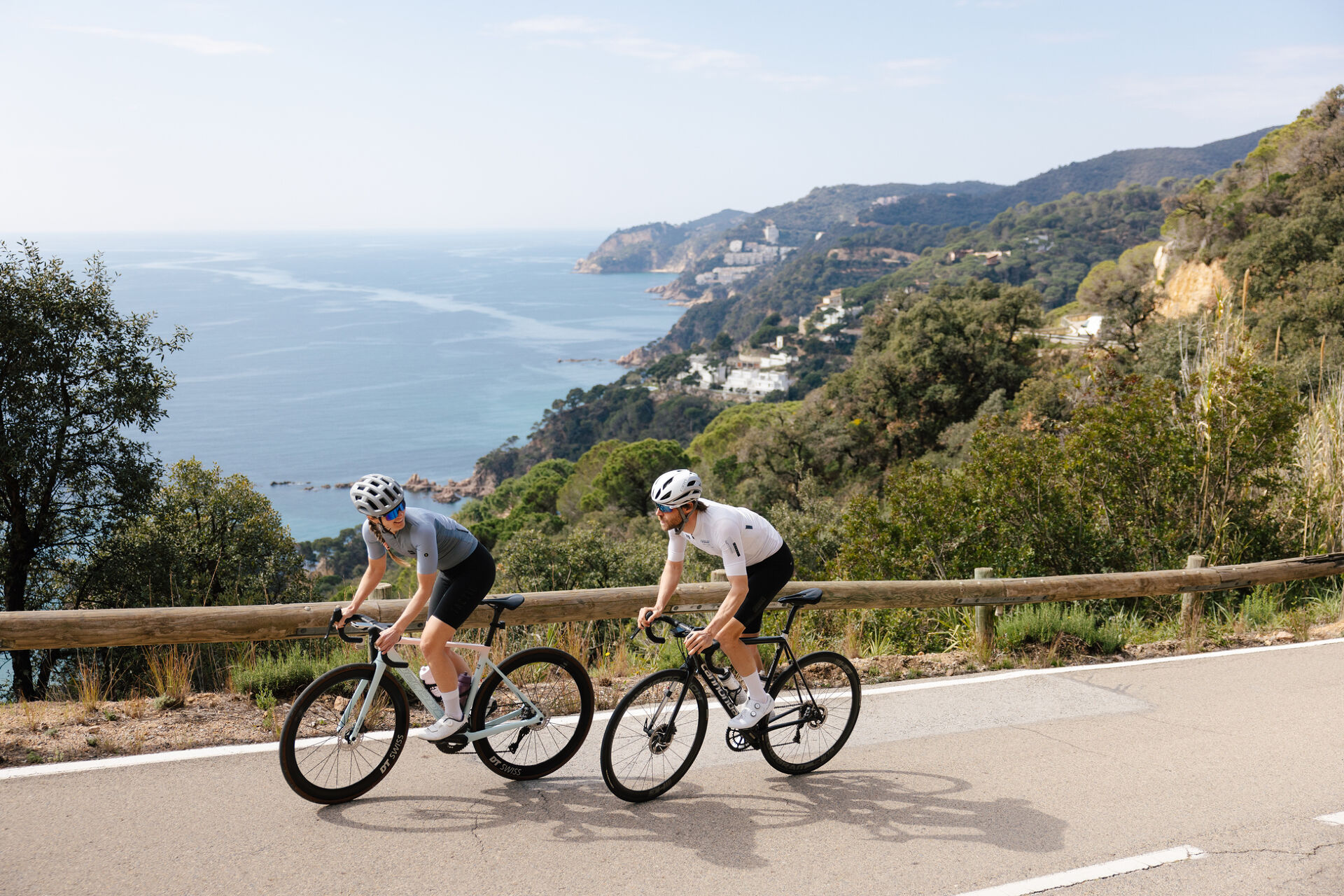
Lloret de Mar - Sant Grau - Romanyà de la Selva - Lloret de Mar
Lloret de Mar - Sant Grau - Romanyà de la Selva - Lloret de Mar
 Distance:
108 km
Distance:
108 km
 Elevation gain:
1.870 m
Elevation gain:
1.870 m
 Max. Elevation:
411 m
Max. Elevation:
411 m
Water points
- Tossa de Mar
- Llagostera
- Romanyà de la Selva
- Calonge
- Platja d’Aro
- Sant Feliu de Guíxols
Between the sea and the mountains, this route takes us in an anti-clockwise direction, starting with a climb with sea views from Alt de Sant Grau before passing through Romanyà in the heart of the Gavarres Massif and culminating on the most spectacular road of the Costa Brava. This classic route is not to be missed!

|
MOUNTAIN PASSES |
CATEGORY |
DISTANCE |
ELEV. CHANGE |
AV. GRADE % |
MAX. GRADE % |
||
|
Alt de Sant Grau (Cadiretes) |
2 |
7 KM |
4,34 MI |
400 M |
1312 FT |
5,5% |
14% |
|
Alt de Romanyà |
3 |
6 KM |
3,72 MI |
290 M |
951 FT |
4,6% |
8% |
|
SECTIONS WITH TRAFFIC DENSITY / ROAD SURFACE DEFECTS |
HIGH DENSITY |
MEDIUM DENSITY |
LOW DENSITY |
|
Lloret - Llagostera |

Secondary road |
||
|
Llagostera - Romanyà |

Secondary road |
||
|
Romanyà - Calonge |

Secondary road |
||
|
Calonge - S. Feliu Guíxols |

Urban and interurban sections |
||
|
S. Feliu Guíxols - Lloret |

Secondary road |
Departing from the Central Tourist Office of Lloret de Mar located in Carrer de les Alegries, 3, we follow the east exit from the city, crossing Lloret, and take the GI-682 road in the direction of Tossa de Mar.
We cross Tossa de Mar and continue along the same road in the direction of Sant Feliu de Guíxols. This is the start point of one of the best coastal roads that can be ridden on anywhere in Europe. It offers stunning sea views with the towering cliffs and spectacular coves of the Costa Brava, along with a series of climbs and descents that will warm up your legs if you ride with intensity.
At kilometre 21 we come to the turn-off leading to the Chapel of Sant Grau. This marks the start of the ascent of the Sant Grau Pass. With wonderful views of the coast, this is a demanding climb with gradients of up to 14% in some places.
Once we’ve climbed to the top of the pass, a rapid descent takes us down to Llagostera. Leaving the town behind, we take a quiet byroad that links up with the GIV-6612, which eventually leads us to Sant Martí de Romanyà after a pleasant climb. Here we can enjoy the typical landscape of the Gavarres Massif, passing through cork oak forests.
Leaving the pass behind, a pleasant, tranquil descent down to Calonge awaits us. From here we head to Platja d’Aro and quickly back to Sant Feliu de Guíxols. Here we take the GI-682 in the opposite direction. From this perspective it’s also one of Europe’s best coastal roads for cycling, offering stunning sea views with the towering cliffs and spectacular coves.
Once we reach Tossa de Mar we continue along the GI-682 road that leads us back to Lloret, the start and end point of the route.
It’s important to bear in mind that during the high summer season the GI-682 road becomes the main access road to beaches, with dense traffic, and should not be considered a secondary road at this time of year. You should avoid weekends from the second fortnight of June to the second fortnight of September, and it’s best to avoid the entire month of August.
Points of interest
Tossa de Mar: ancient fishing village, easily recognisable thanks to its silhouette featuring the tower of the mediaeval walled enclosure. A town with an aura of glamour ever since Pandora and the Flying Dutchman was filmed there in 1951, starring Ava Gardner, James Mason and the bullfighter Màrius Cabré.
Sant Feliu de Guíxols: a tourist town with a unique architectural legacy, including a fortified Benedictine monastery next to the sea. Porta Ferrada, one of the longest established international summer festivals of music, theatre and dance on the Costa Brava, is held in Sant Feliu.
Gavarres Massif: the landscape of this inland massif is characterised by dense oak forests and scattered farmhouses. With gentle hills and fantastic elevation changes, this area contains some of the favourite climbs of local professional cyclists: Els Àngels, Santa Pellaia, Romanyà, etc.
Sant Grau d’Ardenya: large church in the neo-Romanesque style, attached to a building with the appearance of a traditional Catalan farmhouse. The road to the chapel offers one of the area’s most stunning views of the Mediterranean Sea.